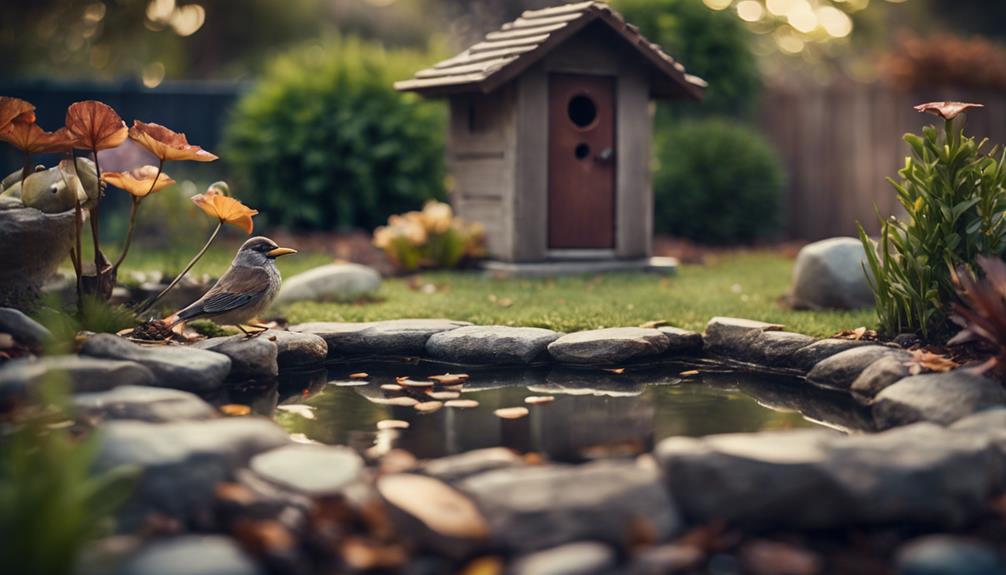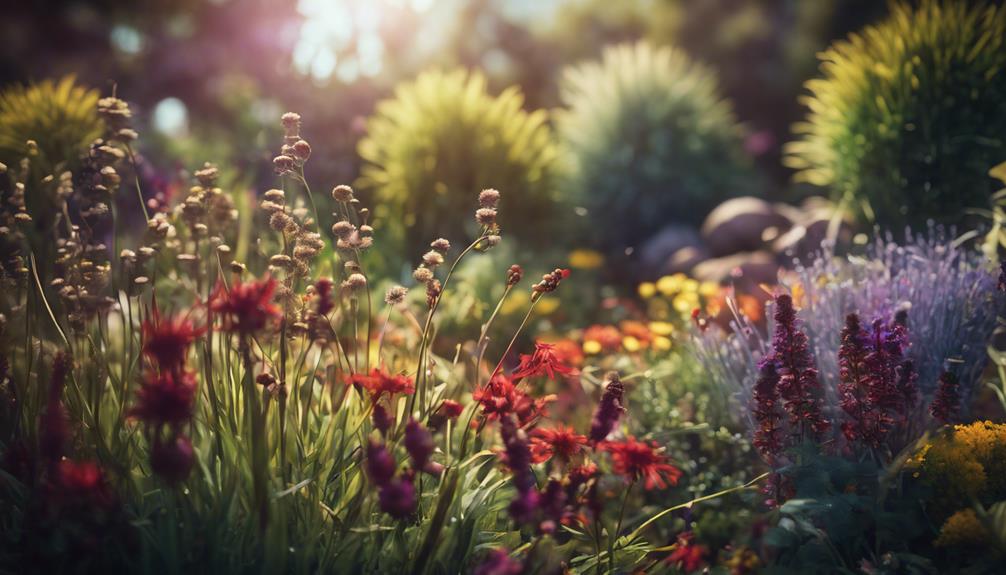You'll want to create a wild and messy space by incorporating native plants that flower at different times, attracting bees and butterflies throughout the growing season. Choose plants with different growth habits, like ground covers, shrubs, and trees, to create a layered habitat. Incorporate fragrant flowers, like meadow clary and lavender, which attract a variety of pollinators. Support butterfly-loving plant species, such as milkweed and butterfly bush, to provide essential food sources. Finally, add wildlife-friendly garden elements, like native trees and shrubs, to create a functional haven. As you craft your biodiverse garden, you'll discover even more ways to support local wildlife.
Table of Contents
Key Takeaways
- Choose native species that offer diverse habitats and food sources for local wildlife, ensuring a thriving ecosystem.
- Select plants with different growth habits, like ground covers, shrubs, and trees, to create a layered habitat.
- Incorporate plants that attract different types of pollinators, like bees, butterflies, and hummingbirds, to promote a healthy food chain.
- Consider plants that add organic matter to the soil, like leaf litter or roots, to support microorganisms and invertebrates.
- Mix plants that bloom at different times to provide a constant source of food and habitat throughout the year.
Create a Wild and Messy Space
By embracing a more relaxed approach to gardening, you can create a wild and messy space that becomes a thriving haven for biodiversity.
This untidy area will provide a natural haven for local wildlife, offering food and habitat for many species.
By choosing native plants that flower at different times, you'll create a diverse space that attracts bees and butterflies throughout the growing season.
A mix of wild plants and flowers will attract a variety of insects, birds, and other animals, providing shelter and nesting sites for them.
This diversity within your garden will support natural processes, allowing your garden to become a thriving ecosystem.
By leaving a section of your garden unmanicured, you'll allow natural debris to accumulate, providing a crucial source of food and habitat for many species.
Choose Plants for Biodiversity
As you design your biodiverse garden, you'll want to select plants that provide a diverse range of habitats and food sources for local wildlife, ensuring a thriving ecosystem.
To achieve this, choose native species that offer a variety of food sources, such as pollen and nectar, seeds, fruits, and leaves. Consider plants with different growth habits, like ground covers, shrubs, and trees, to create a layered habitat.
Incorporate plants that attract different types of pollinators, like bees, butterflies, and hummingbirds, to promote a healthy food chain.
When selecting plants, look for those that add organic matter to the soil, like leaf litter or roots, to support microorganisms and invertebrates.
Aim for a mix of plants that bloom at different times to provide a constant source of food and habitat throughout the year.
By selecting plants that cater to various wildlife needs, you'll create a biodiverse garden that's teeming with life. Remember, the key is to create a variety of species that work together to support a thriving ecosystem.
Incorporate Fragrant Flowers Naturally

You can attract a variety of pollinators, including butterflies and bees, by incorporating fragrant flowers naturally into your biodiverse garden. These flowers provide essential food sources for pollinators, supporting their navigation and survival. By incorporating different species of fragrant flowers, you'll attract a greater variety of pollinators, which are essential for seed and fruit production.
| Fragrant Flowers | Attracts | Blooming Period |
|---|---|---|
| Meadow Clary | Butterflies, Bees | Summer |
| Turkish Sage | Bees, Hummingbirds | Spring-Fall |
| Lavender | Bees, Butterflies | Summer-Fall |
| Rosemary | Bees, Butterflies | Spring-Summer |
When newly planted, fragrant flowers can be especially appealing to pollinators, which use their sense of smell to locate nectar-rich flowers. By incorporating a variety of fragrant flowers, you'll create a haven for pollinators and support the local ecosystem. This, in turn, will enhance the biodiversity of your garden, attracting a greater range of plant species and supporting their growth and development.
Support Butterfly-Loving Plant Species
Select butterfly-loving plant species that provide essential resources, such as nectar, host plants, and shelter, to create a welcoming habitat for these iconic pollinators.
The good news is that you can attract these beautiful creatures to your garden by choosing the right plants.
Milkweed for monarch butterflies, which provide a crucial food source for caterpillars.
Butterfly Bush for adult butterflies, offering a rich source of nectar.
Dill for black swallowtails, which use the plant as a host for their caterpillars.
Fennel for anise swallowtails, providing a food source for their caterpillars.
Some particularly useful species to ponder:
When selecting plants, make sure to choose varieties that are native to your region and use organic gardening practices to avoid harming these delicate creatures.
Plants come in a variety of shapes, sizes, and flower and fruit colors, so you're sure to find something that fits your garden's style.
Add Wildlife-Friendly Garden Elements

Beyond attracting butterflies with targeted plant species, incorporate wildlife-friendly garden elements to create an all-encompassing haven for local fauna.
You can achieve this by incorporating native trees and shrubs, which provide shelter and food for a greater variety of species. Weigh buying plants that are native to your region, as they're more likely to thrive and support local wildlife.
When creating a garden, don't forget to include organic mulch, which helps retain moisture and suppress weeds. This will allow you to create a haven that's not only beautiful but also functional.
In a large country like yours, it's vital to take into account the specific needs of each species within your region.
By doing so, you'll be able to create a biodiverse garden that's tailored to the unique needs of your local ecosystem. When selecting plants, look for those that provide nectar, pollen, or seeds, as these will attract a wide range of wildlife.
Frequently Asked Questions
How to Make a Biodiverse Yard?
To create a biodiverse yard, you'll start by selecting native plants, then prepare the soil, design a thoughtful garden layout, incorporate water features, and create microclimates to attract beneficial insects, all while optimizing sunlight.
Which Species of Dogwood Do You Plant to Promote Biodiversity in Your Yard?
When it rains, it pours – you're spoiled for choice with dogwood species! Consider Cornus alternatives like Cornus mas for winter interest, Cornus kousa for pink flower color, and Cornus alternifolia for soil tolerance and deer resistance, factoring in mature size and foliage texture.
How Do You Increase Species Diversity?
You increase species diversity by thoughtfully selecting species, minimizing habitat fragmentation, and leveraging edge effects, while creating microclimates, promoting soil heterogeneity, and mimicking natural disturbance regimes through strategic native introductions.
How to Increase Bird Biodiversity?
You're likely aware that one-third of North America's bird species are in decline, which is alarming! To increase bird biodiversity, you can install bird feeders, plant native shrubs and fruit trees, incorporate water features like bird baths, and create insect hotels to attract a diverse range of species.
Conclusion
By following these 5 tips, you'll be well on your way to creating a biodiverse garden that's teeming with life.
And it's more essential than ever: did you know that 40% of insect species are at risk of extinction, with butterflies and moths being particularly hard hit?
By incorporating butterfly-loving plants and wildlife-friendly elements, you'll be providing a pivotal haven for these key pollinators.
Your garden can make a real difference – so get planting!

